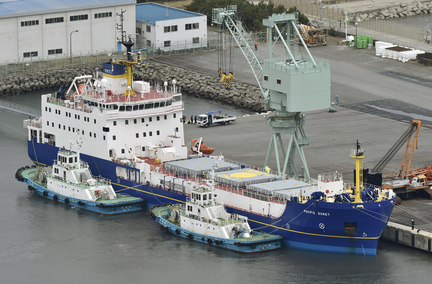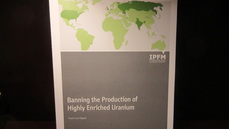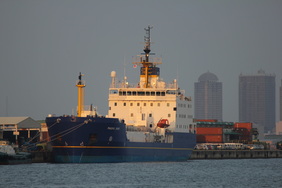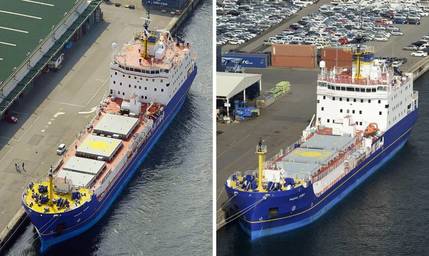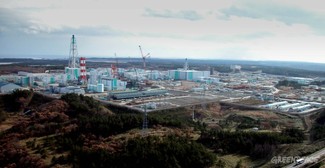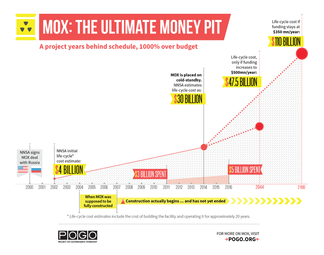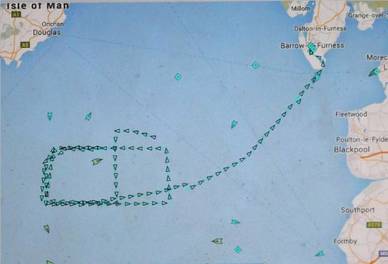“MOX gets mixed grades from Energy Department –
Contractor’s award more than halved”
Augusta (Georgia) Chronicle, April 29, 2016 – linked here
– article based on the NNSA award fee documents released by SRS Watch – news release linked here
Note: NNSA Determined that the MOX construction “Overall performance below the level needed for successful project execution” and that Drug Testing is Inadequate! But is NNSA laying down the hammer on this abysmal situation or are construction problems and drug testing problems dragging on and on (as we’re hearing)?
BTW, MOXie says “oink” and enjoys another trough full of tax payer money, topped off by the award fee bonus given to CB&I AREVA MOX Services by NNSA for FY 2105. We are not at liberty to say where that lard of cash went when MOX $ervcie$ mismanagers got their bonus checks.
—–
Is the MOX Plant Design Faulty or Will it Work?
Where is any proof that the design will work? Did naive NNSA officials buy a pig in a poke from AREVA and not adequately review what they were purchasing?
There are hints from various corners that NNSA rushed into purchasing a system that won’t work to US standards and that construction of the plant began too far in advance of the design being mature enough for construction to have taken place. Here’s one such public indication of design (and other) problems, which merits a follow-up report by DOE.
“Improving Project Management”
U.S. Department of Energy – Report of the Contract and Project Management Working Group – linked here
November 2014
page 22:
Prior to developing the project’s baseline, DOE did not conduct peer reviews; analyze France’s reference plants’ construction costs or operations history that were the basis of the MOX program; or perform a rigorous technology development review, risk analysis or project definition rating. DOE and the contractors relied on the fact that similar facilities, although built decades earlier and under different regulatory, political, and industry conditions, could easily be modified and replicated in the United States. Under the DOE orders at the time, there was no requirement to ensure that design was sufficiently mature or that the project’s cost estimate be performed by an independent party.
In April 2007, DOE approved a baseline for the capital construction costs for the MOX project at $4.8 billion. This approval largely relied on the cost estimate, design status, and risk program developed by the contractor. Subsequently it was determined that the design was significantly less mature than had been reported; the risks associated with meeting U.S. regulatory and building codes were not well understood; and the current state of the nuclear industry’s supply chain in both labor and material procurements was significantly underestimated. Design costs continued to grow, construction and procurement bids greatly exceeded estimates, and technical staff turnover was much higher than anticipated. Insufficient research into the supply chain’s ability to meet the projects rigorous Nuclear Quality Assurance‐1 (NQA‐1) criteria limited available sources and significantly increased oversight and procurement costs.
MOXie, Senator Lindsey Graham’s pet pork-barrel pig, is eating massive amounts of money from the public trough. But neither Lindsey nor NNSA nor CB&I AREVA MOX Services have been able to make a case that MOXie will perform as hoped. Will this all come out in any MOX hearings to be held by the Armed Services committees or will the cover-up keep the lid on this critical issue?
—–
“Accident-free hours count reset at MOX site”
…and more on MOX and testing for illegal drug use
Augusta (Georgia) Chronicle, April 27, 2016 – linked here
The article is incorrect about the bonus fee award for the MOX project in Fiscal Year 2015 – the rating was 49%, which the DOE’s National Nuclear Security Administration (NNSA) called “satisfactory.” It is disturbing to read that the NNSA determined that “Overall performance is below the level needed for successful project execution, as culminated in cost overruns and schedule delays.”
On the troubling issue of MOX workers and drugs, the award fee narrative said “During this assessment NNSA found that MOX Services is not implementing random drug testing in a manner that is compliant with the procedure and is therefore not appropriately providing assurance of a drug free workplace.” See SRS Watch news of April 21, in which the award fee documents, obtained under a Freedom of Information Act (FOIA) request, were released – linked here.
ATTENTION: If you have information about illegal drug use or use of synthetic urine or other methods to trick drug testing at the MOX project, please let us know: srswatch@gmail.com, tel 803-834-3084. The rumors of drug use by MOX workers must be investigated and, if possible, laid to rest.
—–
Oink indeed! Senator Lindsey Graham’s favorite pork-barrel project: MOX
Time again to take a look at the 2103 Friends of the Earth video about the MOX boondoggle, which Senator Graham has been protecting. Now that Graham has admitted that MOX isn’t viable at the current funding level, it’s only a matter of time until he faces the facts and cuts CB&I AREVA MOX Services loose and agrees to MOX termination.
CB&I AREVA MOX Services has wasted billions of our tax payer dollars on its mismanagement of the MOX project and our money must be stopped being poured down the MOX black hole.
—–
NY Times, April 17, 2016 print editionarticle linked here
>>> Recall that SRS processes all the radioactive tritium gas used in US nuclear weapons, to boost their explosive power. In violation of nuclear non-proliferation norms, that tritium is produced by irradiating special rods in the Watts Bar unit 1 commercial reactor – Watts Bar Nuclear Bomb Reactor (WBNBR) – operated by the Tennessee Valley Authority (TVA). Highly radioactive tritium rods are processed at the Tritium Extraction Facility (TEF) at SRS and packaged into small containers that are inserted into nuclear warheads.
photos: entrance to Tritium Extraction Facility (TEF) at SRS & tritium reservoir to be inserted in a nuclear warhead & aerial shot of H-Area at SRS, where TEF is located (to the right and adjacent to the H-Canyon reprocessing plant, the long, narrow building in the center of the photo)
—–
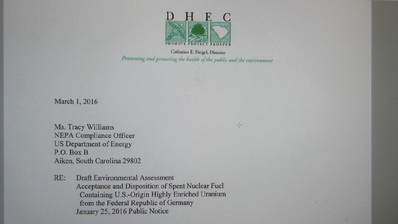
South Carolina Department of Health and Environmental Control (DHEC)
— comments of March 1, 2016 on the plan to import and dump German commercial spent fuel at SRS
Thanks to DHEC for these thoughtful, critical comments submitted for the record of the draft environmental assessment!
—–
International Panel on Fissile Materials (IPFM)
“Dealing with Russia’s concerns about the isotopics of disposed plutonium”
Drs Edwin Lyman and Frank von Hippel, April 15, 2016
Senators Lindsey Graham and Tim Scott of South Carolina have interpreted remarks by Russian president Putin on the 2000 U.S.-Russian Plutonium Management and Disposition Agreement (PMDA) as requiring that the United States continue with the costly MOX project in South Carolina. President Putin objected to the less costly dilute and dispose approach proposed by the Obama Administration because the plutonium could be recovered and “converted into weapons-grade plutonium again.” RT reported a Rosatom spokesman explaining, “The only way to irreversibly turn plutonium into a material not usable in a nuclear weapon is by changing its isotope composition. Any chemical method is reversible.”
—–
“Ex-appropriator laments ‘nuclear bridge to nowhere'”
– uh, that would be CB&I AREVA MOX Services’
MOX mega-boondoggle being protected from accountability by Senator Lindsey Graham
by Hannah Hess, E&E reporter
E&E Daily: Wednesday, April 13, 2016
—–
SRS Watch in the news:
“House panel votes to keep MOX funding steady”
[note: it wasn’t a vote but a committee recommendation, which has great weight…]
“Savannah River Site contractor resumes full operations”
— both in Augusta (Georgia) Chronicle, April 13, 2016
—–
SRS research documents of interest, March 2016:
“EXAMINATION OF SHIPPING PACKAGE 9975-02403” – used for storage of 13 MT of plutonium in the K-Area at SRS
Savannah River National Lab (SRNL), March 2016
“Further examination of this package in SRNL confirmed significant moisture and mold in the bottom layers of the lower fiberboard assembly, and identified additional corrosion along the seam weld and on the bottom of the drum.”
“Overcoming Waste Removal Challenges at Savannah River Site: A Case Study of Tank 15”
Savannah River Remediation (SRS high-level waste contractor), March 2016
– how SRS addressed problems with dried highly radioactive sludge in the bottom of Tank 15
—–
Important article on plutonium disposition:
“US, Russia Can Agree on Plutonium Disposition Without Renegotiations”
Sputnik International, April 12 2016
State Department’s Daily Press Briefing of April 11, 2016 – on US-Russia Plutonium Management and Disposition Agreement (PMDA) – linked here
QUESTION: Plutonium case. So today’s – today Russian foreign ministry’s official Mikhail Ulyanov* said that Moscow did not allow to change the method of disposal of plutonium. So that’s the case and that’s the main point in that agreement between Russia and United States. So could you clarify United States position in terms of method of disposal? I mean —
MR TONER: What I can say is that since 2013 we’ve been in communication with Russia about the U.S. review of disposition methods and its results that’s consistent with the U.S.-Russia Plutonium Management and Disposition Agreement. And this agreement essentially provides a path for the parties to consult and agree on disposition methods that do not involve irradiation in nuclear reactors. So I wouldn’t speculate – I wouldn’t speculate on what he meant in his remarks. I’m just saying what we’re trying to adhere to in this process.
QUESTION: So are you ready to have a new round of consultations with Russia with respect to this case?
MR TONER: I mean, I think we’re in communication with Russia on this. I don’t think we’re necessarily – I don’t think accommodating any kind of new method would necessarily require a renegotiation of the agreement, certainly, but I’m not going to speculate beyond that.
—–

by Gordon MacKerron, in spinwatch (Public Interest Investigations), Uk, 5th April 2016 – linked here“The decision to move this radioactive waste out of the UK has been presented as making it harder for nuclear materials to get into the hands of terrorists, but this is implausible. The UK is capable of managing homegrown highly enriched uranium itself. The plan also contradicts the principle that countries are responsible for managing their own nuclear legacy.”
photo: ©Cumbrians Opposed to a Radioactive Environment (CORE), Pacific Heron and Pacific Egret in their home port of Barrow, UK in January 2016.. Will these armed ships be used for the HEU transport from Dounreay to the US? These ships are now on a mission to dump plutonium in Japan on SRS.
—–
“WIPP is logical repository for plutonium – done right”
Albuquerque (New Mexico) Journal editorial, April 7, 2016
—–
”Gov. Nikki Haley backs plutonium removal from Savannah River Site, reasserts MOX lawsuit”
Charleston (South Carolina) Post & Courier, April 6, 2016
SRS Watch news release of October 27, 2015 outlining why the plutonium-removal law can’t be enforced and is but a cynical effort by Senator Lindsey “MOXie” Graham to support the now-failed MOX project: linked here
—–
“Toxic decisions show contempt for Scotland” (re shipment of Dounreay spent fuel to SRS, HEU to US with no public consultation in Scotland)
The National editorial, Scotland, April 7, 2016
”Questionable HEU exchange between United Kingdom and United States”
International Panel on Fissile Materials (IPFM) blog,
April 5, 2016 — linked here
“Cameron urged to tell the truth over Dounreay US nuclear export”
The National (Scotland), April 6th 2016
- article linked here
—–
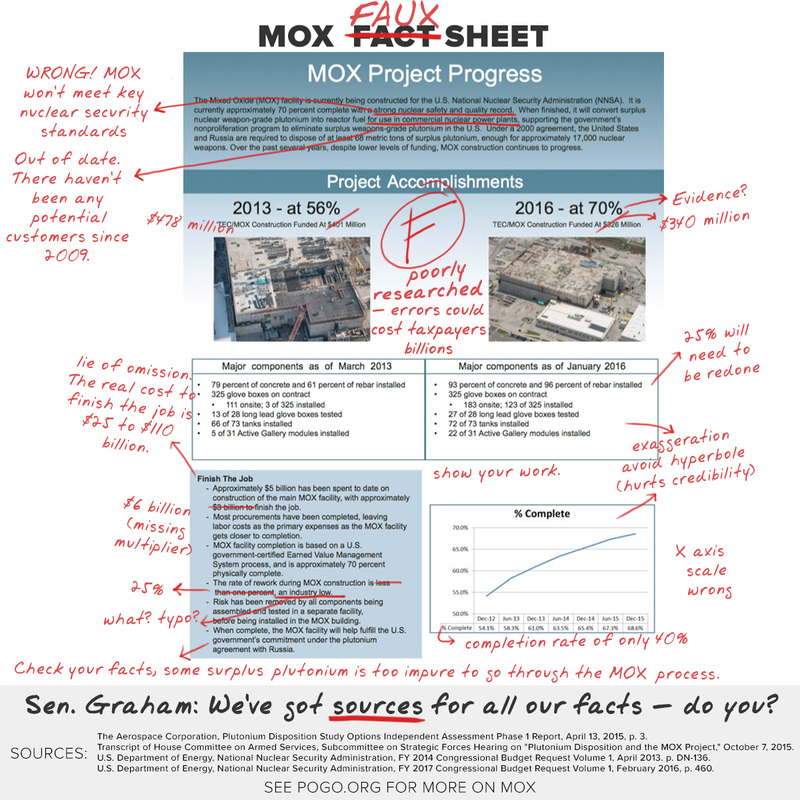
Lindsey’s MOX Faux Sheet!
Senator Lindsey Graham’s MOX falsehoods get nailed by the Project on Government Oversight (POGO), April 5, 2016.
Senator Graham continues to protect his pet boondoggle – MOX – and serve the interest of CB&I AREVA MOX $ervices but the failed project is tumbling in on him.
Graham can continue to waste US tax payer money and oppose the slow-motion termination of the MOX train wreck but his efforts are doomed as MOX isn’t viable. As the facts are lined up against him, Graham still has not even attempted to present a way forward to address lack of funding or how design and construction problems and lack of MOX customers can be addressed.
Graham just wants to spend our money until the clock runs out on the MOX debacle. How’s that for being a public servant supposedly beholden to the tax payers?!
As his grade on his MOX Fuax Sheet says: he gets a big fat “F” for his abysmal performance!
—-
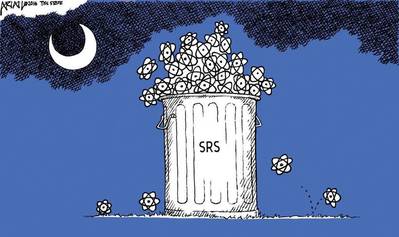
Robert Ariail, cartoonist:
“South Carolina’s spring bouquet”
— concerning plutonium and nuclear waste being dumped on the US DOE’s Savannah River Site (SRS), with no viable or funded exit strategy
in The State newspaper, Columbia, South Carolina, April 5, 2016
—-

Cumbrians Opposes to a Radioactive Environment (CORE), 4 April 2016 – SRS Watch partner group near the UK’s Sellafield nuclear site”
Plan agreed with stakeholders to manage the ‘Exotic’ HEU fuel at Sellafield ditched without consultation in covert deal rushed through with Government to meet Washington Summit timetable.”CORE press release linked here
—–
“US plea: don’t dump Dounreay’s nuclear waste here”
The Ferret, UK news site, 4 April – linked here
—–
SRS Watch in
“US-Umweltaktivist will Planungen für einen gefährlichen Atommülltourismus ein Ende setzen”
”US environmental activist wants to put an end to plans for a dangerous nuclear waste tourism”
– on stopping illegal German commercial spent fuel dumping at SRS, with proposed transport in CASTOR casks
German website lokalkompass.dem, March 31
—–
SRS Watch on HEU from the UK to the US, April 2, 2016
“Nuclear material in U.S. swap with United Kingdom not planned for SRS”
Aiken (South Carolina) Standard, April 2, 2016
“U.S. will take weapons-grade uranium from Britain”
USA Today, March 2, 2016
——
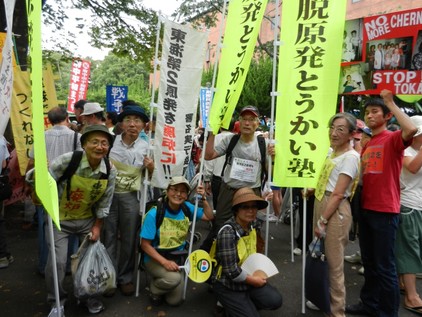
Citizens Nuclear Information Center, Tokyo, March/April 2016“The shipment of weapons-grade plutonium at the port of Tokai, Ibaraki prefecture departing later today, exposes the failure of global plutonium reprocessing programs and the threat from current Japanese nuclear policy, five non-governmental organizations charged today.(1) The cargo of 331kg of plutonium was loaded on to the Pacific Egret, an armed British nuclear transport ship, after it arrived at Tokai at 08.00 March 21st. Armed Japanese coastguard vessels, including the Shikishima, are outside the port and are expected to escort the plutonium shipment while inside Japanese coastal waters. The shipment is being undertaken in a failed U.S. policy attempt to reduce the threat from nuclear weapons materials worldwide.”
linked here
—–
As we have been hearing, activities by DOE to terminate the failed MOX project are beginning:
“Spokesperson: Layoffs affect around 60 employees at Savannah River Site MOX project“
Aiken Standard, April 1, 2016
article linked here
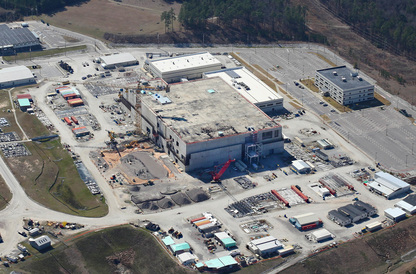
“Senator Lindsay Graham’s international training center” at the abandoned MOX plant? Great idea from the Union of Concerned Scientists!
“The Perfect Gift for the Nuclear Security Summit”
Union of Concerned Scientists blog, March 31, 2016
linked here
Senator Graham has placed the MOX plant around his neck like a lead albatross and protected the boondoggle every step of the way. As MOX is terminated, doesn’t he at least deserve this memorial for his waste of $5 billion of our tax money? At least there may be some future use of the big concrete box that has served as Lindsey’s piggy bank for CB&I AREVA MOX Services…..
photo: MOX plant on March 6, 2016, “©High Flyer, special to SRS Watch” – can be used with this credit
—–
“Scientists recommend closing MOX and exploring other alternatives”
Aiken South Carolina Standard, March 30, 2016
—–
World to Japan: Halt your Program to Continue Separating and Stockpiling Weapon-Usable Plutonium!
SRS Watch agrees and has signed the letter linked below (which mentions the plutonium shipment now underway from Japan to SRS).
In advance of the Nuclear Security Summit Washington, March 31-April 1), a large number of international groups are calling for Japan to live up to its nuclear non-proliferation commitments and halt its program to separate and use weapon-usable plutonium. Will the summit live up to the obligation to speak up against Japan’s plutonium stockpiling program? Letter:
To: Mr. Shinzo Abe
Prime Minister of Japan
March 28, 2016
要請:プルトニウムの分離を止めることによって世界の核セキュリティー強化に貢献すること
Subject: Call to help strengthen worldwide nuclear security by stopping plutonium separation
We, the undersigned, call on Prime Minister Shinzo Abe and the Government of Japan to make a strong contribution to the Nuclear Security Summit by announcing the indefinite postponement of the operation of the Rokkasho spent nuclear fuel reprocessing plant.
下に署名した私たちは、安倍晋三総理大臣と日本政府に対し、六ヶ所使用済み核燃料再処理工場運転の無期限延期を発表することにより、核セキュリティー・サミットに大きな貢献をするよう要請します。
full letter linked here, in English & Japanese
list of 175+ signatories linked here
photo: Japan’s Rokkasho reprocessing plant, which has failed to start-up after a decade of failed attempts, by Greenpeace
For details on Japan’s plutonium stockpiling program – see
Nuclear Proliferation in Plain Sight: Japan’s Plutonium Fuel Cycle–A Technical and Economic Failure But a Strategic Success”
– in The Asia-Pacific Journal, March 2016, linked here
—–

SRS Watch in Reuters article, March 24, 2016:
“South Carolina governor urges U.S. to divert plutonium from Japan”
article linked here
letter from Gov. Haley to DOE linked here
—–
AMAZING: detailed aerial shots of the plutonium-loading operation in Tokaimura, Japan on March 22, with Japanese coast guard escort vessels, a Japanese colleague’s attempt to fly a small drone on the beach and the departure of the pirate ship Pacific Egret in direction: South Carolina
TBS News
プルトニウム積んだ輸送船、アメリカに向け出港
“Plutonium laden transport ship, sailing towards the United States”
http://news.tbs.co.jp/newseye/tbs_newseye2730942.html
—–
linked here
March 23, 2016: Governor Nikki Haley (South Carolina) to Secretary of Energy Moniz: Stop Plutonium Shipment from Japan or Reroute!
The governor says South Carolina is “at risk of becoming permanent dumping ground for nuclear materials” & pay up on $1 million/day fine for not starting to remove plutonium from the state by January 1, 2016, as required by law (due to the failure of the MOX project).
SRS Watch is appreciative that the governor is paying attention to what DOE is up to, under the guise of nuclear non-proliferation.
Where will the plutonium pirate ships go when the port of Charleston (right by Fort Sumter) is blockaded starting on May 5, 2016? As we’ve been saying all along: Send 236 kg of the plutonium to Sellafield, UK and 2 kg to La Hague, France, where the massive plutonium stockpiles are bursting at the seams. DOE/White House remain stunned into silence and unable to explain why bringing UK plutonium to SRS comprises sound nuclear non-proliferation policy. (It ain’t…)
March 23 governor’s letter linked here
Articles of March 23 with SRS Watch:
AP article: “Governor Tells Feds to Stop Sending Plutonium” – linked here
Charleston (South Carolina) Post & Courier: “Gov. Nikki Haley to feds: Stop sending nuclear materials to South Carolina” [via port of Charleston] – linked here
—–
Wow! “Gov. Nikki Haley is telling federal officials to stop sending nuclear materials to a site in South Carolina”
The governor is catching on to the nuclear dumping we are facing. Good for her!
By MEG KINNARD Associated Press, March 23, 2016 – 1:27 pm EDT –
COLUMBIA, South Carolina — Gov. Nikki Haley says it’s imperative that federal officials stop sending nuclear materials to South Carolina.
In a letter obtained Wednesday by The Associated Press, Haley tells Energy Secretary Ernest Moniz to stop or reroute a shipment of 331 kilograms of plutonium coming to the Savannah River Site from Japan.
Tons of plutonium have accumulated over the years at the former nuclear weapons complex, where a facility to process such materials into commercial nuclear reactor fuel remains incomplete.
South Carolina is already suing the federal government over what Haley has called its broken promise to the state to finish the mixed-oxide fuel facility, The lawsuit seeks daily fines of $1 million and removal of the plutonium.
The Energy Department has not responded to the lawsuit in court.
—–
SRS Watch in:
“Japan sends weapons-grade plutonium to the United States”
Asahi Shimbun, Tokyo, March 23, 2016
article linked here
image: “Stop Rokkasho Reprocessing Plant” –poster (by Shunji Arakawa) pdf file
——
“More Nuclear Dumping In SC –
BATTLE SET TO RAGE OVER PLUTONIUM SHIPMENTS …”
FITSNEWS, March 22, 2016
blog post linked here
——
“Plutonium from Japan reportedly headed to SRS”
Aiken (South Carolina) Standard, March 22,2016
—–
Loading of ISO containers with plutonium (and HEU?) containers inside has taken place in Japan – destination:
SRS, March 22, 2016
Kyodo News article, with photo:
http://this.kiji.is/84813463827695101?c=39546741839462401
プルトニウム輸送船に積載
米に向け出航へ
茨城県東海村の東海港で22日、日本が米国への返還に合意した研究用プルトニウムを運搬するとみられる英国の輸送船に、クレーンでコンテナが積み込まれた。近く米国に向け出航する見通し。
核物質の管理強化を進めるオバマ米政権の方針に基づく返還で、米南部サウスカロライナ州にある米エネルギー省のサバンナリバー核施設に運び込み、最終処分する予定。日米両政府は、核防護を理由に輸送ルートや到着時期を明らかにしていない。
輸送船「パシフィック・イグレット」は21日午前8時ごろ、東海港に到着。海上保安庁の巡視船が警備するなか、22日午前、複数のコンテナをクレーンで積み込んだ。
見る
photo:
コンテナが積み込まれる、輸送船「パシフィック・イグレット」=22日午前8時30分、茨城県東海村
Loaded on plutonium transport ship
To sail towards the US
Tokai-mura, Ibaraki Prefecture in the East Sea Port 22 days, Japan is in the British transport ship, which is expected to carry the research for the plutonium that was agreed to return to the United States, the container has been loaded with a crane. Near sailed to outlook towards the United States.
In return based on the Obama administration’s policy to promote the strengthening management of nuclear material, Hakobikomi the Savannah River nuclear facility of the US Department of Energy in the US southern South Carolina, plans to final disposal. The Governments of Japan and the United States, did not reveal the transport routes and arrival time because of the nuclear protection.
Transport ship “Pacific Iguretto” is at around 21 days 8 am, arrived at the East Sea Port. Amid Japan Coast Guard patrol boat to security, 22 days morning, embarked multiple containers with a crane.
photo (of ISO container being loaded): Container is loaded, transport ship “Pacific Iguretto” = 22, 8:30 am, Tokai-mura, Ibaraki Prefecture
—–
Greenpeace & NGO news release, March 22, 2016
Plutonium Shipment to Depart Japan for United States
– Exposes Failure Of Global Reprocessing Programs
March 22nd 2016, Tokyo…The shipment of weapons-grade plutonium departing as soon as later today from the port of Tokai, Ibaraki prefecture, exposes the failure of global plutonium reprocessing programs and the threat from current Japanese nuclear policy, five non-governmental organizations charged today.(1) The cargo of 331kg of plutonium was loaded on to the Pacific Egret, an armed British nuclear transport ship, after it arrived at Tokai at 08.00 March 21st. Armed Japanese coastguard vessels, including the Shikishima, are outside the port and are expected to escort the plutonium shipment while inside Japanese coastal waters. The shipment is being undertaken in a failed U.S. policy attempt to reduce the threat from nuclear weapons materials worldwide.
The plutonium cargo to Charleston, South Carolina, in the United States, is sufficient to make over 110 nuclear weapons. However, the plutonium stockpile remaining in Japan is sufficient for over 1800 nuclear weapons, and the nation’s total plutonium stocks of over 47,000 kg – including material stored in France and the UK – is sufficient for over 9400 nuclear weapons.
—–
SRS Watch in Associated Press article:
“2 British ships arrive in Japan to carry plutonium to U.S.” [Savannah River Site]
March 21 AP article from Tokyo liked here
photo: “The Pacific Egret, one of the two British-flagged ships arrived in Japan, is anchored at a port in the village of Tokai, northeast of Tokyo, Monday morning, March 21, 2016, to transport a cache of plutonium worth dozens of atomic bombs to the U.S. for storage under a bilateral agreement. Japan’s Kyodo News agency said the two armed ships, operated by Pacific Nuclear Transport Ltd., showed up early Monday on the coast of Tokai, home to the country’s main nuclear research facility, Japan Atomic and Energy Agency. (Shigeyuki Inakuma/Kyodo News via AP) JAPAN OUT, CREDIT MANDATORY”
—–
March 18, 2016 – Nuclear Security Summit Effect News, with Focus on Proliferation Risks of Japan’s Plutonium Stockpiling/Reprocessing Program
Greenpeace news release:
“Secret Plutonium Shipment Exposes Failure of Non Proliferation and Security Policy in Advance of Nuclear Security Summit and the Threat from Japanese Plutonium Stockpiling”
reprinted in PanOrient News: linked here
Tokyo – (PanOrient News) A coalition of five non-governmental organizations warned today that a shipment of weapons-grade plutonium scheduled to depart the port of the Japanese Tokai nuclear station in Ibaraki prefecture this coming weekend highlights the failure, but also the proliferation risks, of the current Japanese nuclear policy.
A cargo of 331 kg of plutonium will be loaded on to the Pacific Egret, an armed British nuclear transport ship, prior to departure under armed escort to the United States. It will be the largest shipment of separated plutonium since 1.8 tons of plutonium was delivered to Japan by controversial Akatsuki-maru in 1992. The two month voyage to the Joint Base Charleston-Weapons Station will then see the plutonium dumped at the Department of Energy Savannah River Site (SRS) in South Carolina. The U.S. National Nuclear Security Administration, which is responsible for the shipment, has identified that storage in Japan poses a security risk justifying its removal.
&
Japan Times article, March 18, 2016: linked here:
“Japan to return 331 kg of plutonium as U.S. official warns of proliferation risk”
OSAKA – A large shipment of plutonium is expected to depart Japan soon amid a warning from a senior American official saying nuclear reprocessing in East Asia could lead to increased amounts of nuclear material that could be used for nuclear weapons.
By late Sunday, two armed British transport ships currently docked in Kobe, the Pacific Egret and the Pacific Heron, are to be dispatched to the Japan Atomic Energy Agency’s port in the village of Tokai, Ibaraki Prefecture, according to Greenpeace, which is monitoring the ships.
The vessels will pick up 331 kg (729 pounds) of plutonium that was sent to Japan by the United States for civil research years ago but can also be used for nuclear weapons. The material will be returned to the U.S. Department of Energy’s Savannah River Site in South Carolina in a trip expected to take about two months.
—–
The International Panel on Fissile Materials (IPFM) released a new research report on March 15, 2016:
Banning the Production of Highly Enriched Uranium
“The long sought after Fissile Material (Cutoff) Treaty or FM(C)T would ban the production of HEU and plutonium for weapons. But HEU also has several non-weapon uses, all of which involve nuclear reactors. Despite the Nuclear Security Summits and other efforts to minimize HEU use, as of late 2015, there were over 150 nuclear-powered submarines and ships – more than half belonging to the United States, that use HEU as fuel in their propulsion reactors. There also were about 100 research reactors, half of them in Russia, and two tritium production reactors and a breeder reactor, also in Russia, fueled with HEU. Finally, HEU neutron “targets” were being used for medical radioisotope production in several countries. Altogether, the equivalent of about 7 tons of weapon-grade HEU are used for these purposes annually, sufficient for about 100 first-generation gun-type nuclear weapons.”
full report linked here: http://fissilematerials.org/library/2016/03/banning_the_production_of_high.html
—–
Cumbrians Opposed to a Radioactive Environment (CORE), a UK-based ally of SRS Watch, has released an update on movement of ships carrying nuclear materials, including from Japan to the Savannah River Site. Briefing of 14 March:
“Barrow’s plutonium ships and their toxic trade at home and overseas”
Without a Disposal Plan, Plutonium at SRS is Forever:
331 kilograms of plutonium in Japan headed to SRS next week on UK-flagged ships, with no plan by DOE to be removed from the site and still no explanation as to why 236 kg of plutonium of UK origin are being dumped at SRS.
Briefing, 14 March 2016
The Oceanic Pintail, the only ship owned by the Nuclear Decommissioning Authority (NDA) docked in Barrow’s Ramsden Dock nuclear terminal early this morning and unloaded a cargo of ‘exotic’ nuclear materials. Comprised of unirradiated plutonium and/or highly enriched uranium, the toxic cargo was loaded on board at the Caithness Port of Scrabster. From Barrow the consignment was transported by rail to Sellafield, with the rail route and local railway stations under heavy police surveillance to prevent hostile actions against the ‘weapons useable’ materials which are prime targets for terrorists.
The use of the 29 year old Oceanic Pintail – now almost 5 years past her sell-by date (company practice has been to retire ships at or before 25 years of service) – and the sea route from Scotland via the often treacherous waters of the Minches from Cape Wrath southwards, has been much criticised as unnecessarily exposing such dangerous cargos to major risks. Having undertaken a familiarisation voyage to the Port of Scrabster in October 2014, the ship left Barrow for Dounreay on 7th March 2016, concealing her route/destination by de-activating her Automatic Identification System (AIS) so that her progress could not be monitored on shipping websites. Generally used in the past only when a ship is actually carrying a nuclear cargo, the turning off of the AIS system even when the ship is unladen is becoming a common – but clearly not fool-proof – practice by Barrow’s nuclear fleet.
Today’s shipment on the Oceanic Pintail was the first of a number yet to be quantified by the NDA who, despite local and national objections, use Sellafield as a national dumping ground for other facilities’ nuclear detritus.
On the other side of the world, two more Barrow-based ships are scheduled to load 331kgs of plutonium from a Japanese research establishment at Tokai Mura in the next few days. Departing from Barrow on 19th January, the armed ships Pacific Heron and Pacific Egret left the docks with extra security crews and AIS turned off.
The ship’s destination – to Japan and onward to the US Port of Charleston – was already known to some observers despite the best efforts of official secrecy and subterfuge. Caught transiting the Panama Canal on 6th February (where all Canal Webcams were turned off during the ships’ passage) the Pacific Heron and Pacific Egret docked in the Japanese Port of Kobe on 4th March. On leaving Kobe, the two Barrow-based ships – owned by Pacific Nuclear Transport Ltd (PNTL) and managed by the NDA’s wholly owned subsidiary International Nuclear Services (INS) – are scheduled to load the plutonium cargo at the Port of Tokai Mura or nearby port around 20th March and, once loaded, head for Charleston via the Cape of Good Hope. The use of the shorter route via the Panama Canal for the loaded ships hs been ruled out by the US Department of Energy (DOE).
As an indication of the unsavoury and dangerous nature of the cargo, the Pacific Heron and Pacific Egret are likely to be closely escorted out of local waters by heavily armed Japanese Coastguard and/or Japanese Maritime Self Defence Force vessels, many of which are already present in the area.
—–
“Nuclear transport vessel, Pacific Egret, in Kobe, Japan port, March 5th 2016” – by Greenpeace
“The Egret and Pacific Heron are lightly armed UK flagged vessels arrived in Kobe from Barrow-in-Furness, England on March 4th. They are in Japan to pick up a cargo of 331 kg of weapons grade plutonium from Tokai in Ibaraki prefecture. The ships, which is expected during March, will transport the plutonium to the US Department of Energy’s Savannah River Site in South Carolina. Japan has a stock of over 10,000kg of weapons usable plutonium stored at facilities across the nation. The shipment is due to be “hailed by Japanese Prime Minister Abe and US President Obama as a major success at the last ever Nuclear Security Summit to be held in Washington DC 31st March despite the fact that it will do little to reduce the security and proliferation threat from Japan`s plutonium program.”
“Photo credit: Juro Yamamoto/Greenpeace”
—–
“Ships prepare to return 331-kg plutonium stash from Japan to U.S.”
– ships now in Kobe, Japan awaiting plutonium pick up, for semi-secret transit to Charleston, South Carolina & SRS – a one-way plutonium trip with no exit out of SRS
Japan Times, March 6, 2016, full article linked here
Note: As 236 kilograms of this plutonium is of UK origin and 2 kg are of French origin, the bulk of the 331 kg are not being “returned” to the US but rather are being dumped in the US. The US should not be engaged in commerce in plutonium for purposes of nuclear dumping disguised as nuclear non-proliferation. Also, at SRS the plutonium will be stranded as there is no viable disposition plan for the plutonium brought from Japan.
WASHINGTON – A U.S. civic group said Friday two ships have arrived in Kobe to transport the massive plutonium stash Japan agreed in 2014 to return to the United States.
The British-flagged ships will pick up the cargo in the village of Tokai, Ibaraki Prefecture, and take it during a 52-day voyage to the Savannah River Site, a U.S. government nuclear facility in South Carolina, according to Savannah River Site Watch.
The Pacific Heron and the Pacific Egret, anchored in Kobe, will transport 331 kg of the highly toxic material, including weapons-grade versions, from the Fast Critical Assembly run by the Japan Atomic Energy Agency in Tokai.
photos above of Pacific Egret and Pacific Heron in Kobe, Japan on March 5, 2016 – from Kyodo News
—–
The Nuclear Security Summit soon to be held in Washington must not dodge the real proliferation risk in Japan, The summit must demand that Japan stop its program to stockpile yet more weapon-usable plutonium removed from commercial spent nuclear fuel (via reprocessing in the Rokkasho reprocessing plant). Japan already possess 10.8 metric tons of plutonium and there is no justification to stockpile more. Efforts to start-up Rokkasho and the plan to use MOX fuel must be terminated.
“Nuclear Proliferation in Plain Sight: Japan’s Plutonium Fuel Cycle–A Technical and Economic Failure But a Strategic Success”
The Asia-Pacific Journal: Japan Focus
March 1, 2016, Volume 14 | Issue 5 | Number 2
by Shaun Burnie, Frank Barnaby, with Tom Clements, Aileen Mioko Smith and Kendra Ulrich
“Five years after the March 11th 2001 earthquake and tsunami destroyed four reactors at the Fukushima Daiichi site, Japan’s nuclear industry remains in crisis. Three reactors are operating as of February 1st 2016, a reduction of 94% of reactors since 2011. Prospects for a restart of even half of the 54 reactors formerly operating are almost zero. For decades the center of the nations nuclear and energy policy was based on the utilization of plutonium to fuel fast breeder reactors, together with the use of plutonium MOX fuel in commercial power reactors. The program has absorbed trillions of yen yet has utterly failed to deliver the energy security used to justify it. The contradictions and technical and financial obstacles, all of which have been evident since the 1970’s, have reached a new critical juncture. Key elements of Japan’s plutonium program are on the edge of complete failure – from the MONJU fast reactor to the Rokkasho Mura reprocessing plant. Major developments in the last months would suggest that fundamental change is on the horizon. However appearances are deceptive. The nuclear establishment is putting in place mechanisms to try and save a program that was always much more than ‘just’ energy security, but also national security. It is Japan’s de facto nuclear weapons status that will increasingly come to the fore, as the justification for the peaceful use of plutonium is exposed further as a delusion. As nuclear proliferation and conflict points escalate in East Asia, Japan’s stockpiling of thousands of kilograms of weapons usable plutonium with no credible peaceful use is driving further proliferation in the region. Two years before the extension of the U.S. Japan nuclear cooperation agreement, the legal basis for the nations plutonium program, the time for a rethink, long past, is more urgent than ever.”
photo: aerial view of Rokkasho reprocessing plant, by Greenpeace. After a decade of efforts to start operation the plant have failed, Japan must commit to supporting international nuclear non-proliferation goals and announce that the plant will never operate.
—–
”MOX: The Ultimate Money Pit – A project years behind schedule, 1000% over budget”
— blog by Project on Government Oversight (POGO), March 4, 2016
—–
Cumbrians Opposed to a Radioactive Environment (CORE) on the antics of the Oceanic Pintail, aka the “Bobtail,” as the ship returned to the UK from a not-so-secret drop-off of plutonium in Charleston, South Carolina – 1 March 2016
“From plutonium pariah to circus pony”
image above: course of the Bobtail as she approached her home port of Barrow-in-Furness, England on 29 February 2016
Just north of Barrow is located the Sellafield nuclear site,where over 125 metric tons of plutonium are stored. You and others may want to know why isn’t European plutonium going to Sellafield or to France and not to SRS? The only response that the US DOE’s NNSA can muster in response is a gobsmacked silence.
—-
SRS Watch in….
UK Ministry of Defence (MoD) “Admits flying nuclear materials between UK and US”
“Campaigners highlight safety risks after defence minister admits there have been 23 such flights in the last five years”
The Guardian, 1 March 2016
—-
SRS Citizens Advisory Board meeting – presentation on alternatives to the failed plutonium fuel (MOX) program
Tuesday, March 29, 2016, 10:30 a.m.
10:30 a.m. Informational Presentation Tina Watson, CAB Facilitator
• Plutonium Disposition: Alternatives to MOX
Presented by Drs. Frank von Hippel & Edwin Lyman
11:00 a.m. Question & Answer Session on Informational Presentation
11:30 a.m. Lunch
SRS Citizens Advisory Board – Full Board Meeting
Tuesday, March 29, 2016
Hilton Garden Inn
1065 Stevens Creek Road
Augusta, GA 30907
8:30 a.m. – 4:30 p.m.
full agenda for March 28-29 SRS CAB meeting
linked here
—–
February 29: 20 kilograms of plutonium from Switzerland’s Paul Scherrer Institut and 500 grams from Germany’s Karlsruhe facility were brought to the Savannah River Site on February 15. Why the total and stunned silence by DOE/NNSA about this?
OK, we know that the US had asked both countries to be quiet abouot the shipment so that an “announcement” could be made at the Nuclear Security Summit in Washington at the end of March. But the news is already out so the 6-week delay in the announcement will make the DOE/NNSA/White House look feckless and bumbling in its handling of this information. As the plutonium will be stranded at SRS, SRS Watch has been glad to provide the public with this information as DOE has totally broken down in its responsibility to the public, especially in South Carolina.
Geheime Plutonium-Transporte: Vier Atombomben unterwegs
“Secret plutonium transports: Four bombs transported”
“The plutonium quantity for four nuclear bombs has recently been transported to the United States under the strictest security measures from Switzerland and Germany about the Lower Saxony harbor in Nordenham. The secret nuclear shipments took place in late January 2016th umweltFAIRaendern had also been reported. According to new information from the Swiss authorities a total of approximately 20 kg of the present powdered plutonium have been sent in two special vehicles across northern Germany to the US from the local Paul Scherrer Institute. From the German Institute for Transuranium Elements in Karlsruhe more than 500 grams of this nuclear material have been delivered to the Department of Energy in a further transport according to the BMUB.”
BMUB = Bundesministerium für Umwelt, Naturschutz, Bau und Reaktorsicherheit = German Ministry for the Environment, Nature Conservation, Building and Nuclear Safety
—–
See the Video of the US Senator with Plutonium MOX Egg all Over his Face; in Full Retreat, Senator Graham Mounts Not Even a Whisper of Defense for His Failed MOX Program
Should $enator Graham be Forced to Walk the Plank for His Unbridled Boosterism of MOX and Protection of CB&I AREVA MOX $ervices for its Role in the Failed MOX Project? Was Graham paid, or not, to let pork-barrel politics trump sound non-proliferation policy and fiscal conservatism?
Senator Graham’s protection of the MOX boondoggle from accountability is unraveling! Graham predictably dodges his own responsibility in almost complete lack of oversight of the debacle. Following what he said at the hearing, it’s clear that he and many should be fired over this travesty. We’ll raise Graham’s ante a notch or two: what about fines and jail for the waste, fraud, abuse and mismanagement that SRS Watch has been warning about?!
See the amazing Senate Armed Services video from February 24 subcommittee hearing in which Senator Lindsey “MOXie” Graham does the South Carolina 2-step in dodging his responsibility in protecting the MOX boondoggle.
Graham says those responsible should be fired. Well, those firings should start with him! His cover-up and protection of the MOX debacle from accountability is shameful and is a clear demonstration of exactly what is wrong with the government. For years, he has ignored people in his own state and others saying what’s wrong with the MOX project.
— video link posted on Times & Democrat newspaper website, Feb. 24:
“During a Senate Armed Services Strategic Forces Subcommittee Hearing, U.S. Senator Lindsey Graham (R-South Carolina) questioned General Frank Klotz on the MOX program in South Carolina.”
Quote-of-the-hearing from Senator Jeff Sessions, chairman of the subcommittee, who also dodges responsibility:
“We may have to make a tough decision and say Senator Graham, sorry.” (for terminating MOX)
—–


